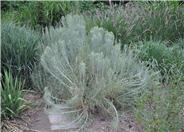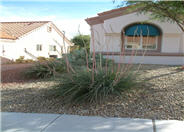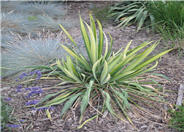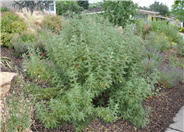
Common name:Big Sagebrush
Botanical name:Artemisia tridentata
Big sagebrush is a Utah native and lives up to its name, growing anywhere from a few to 12 feet tall and 5 to 8 feet wide (the variability is a result of seed source, available water, soil conditions, and other factors that affect growth). It is densed branched with fine textured, silver- to blue-green, aromatic foliage. Inconspicuous yellow flowers appear July through november. The bark is brown, twisted, and scaly. This may not be the ideal sagebrush for a traditional landscape, but it would work well in a naturally-styled setting. Very aromatic.

Common name:Red Yucca
Botanical name:Hesperaloe parviflora
This spectacular succulent grows to 3 to 4 feet tall and wide. Blue green leaves are strap-like, leathery, long, with white fraying fibers on the edges. During the summer, dark pink flowers are seen on arching, red stalks, and reach up to 6 feet. Hummingbirds love these flowers. This evergreen plant is drought tolerant once it's established but will appreciate extra water during the summer to promote blooms. Plant in full sun or light shade, with well draining soil. Deer like the foliage.

Common name:Harriman Yucca
Botanical name:Yucca harrimaniae
Harriman yucca is a striking accent in a dry, naturally-styled landscape. Leaves are evergreen, sword-like, narrow and tappering to a point, with sharp tips, and form clumps to 3 feet tall and wide (though they do colonize over time and can become wider). Flower spires are up to 5 feet tall and are lined with bell-shaped, creamt flowers tinged with purple. The leaves are used to make a course rope.

Common name:Fernbush
Botanical name:Chamaebatiaria millefolium
Fernbush is a wonderful Utah native, well suited to urban life. It has an upright, rounded form, growing about 3 to 5 feet tall. Bright green foliage emerges in the spring, and as the name suggests, has a fern-like appearance. foliage has a lemony-pine scent when bruised. Mid-summer sees clusters of white flowers appearing at the ends of branches. Bark is red and shreddy. Though not typically evergreen in our region, it holds its foliage late into the autumn. Use in the shrub or foundation border, as an informal hedge, or near the veggie garden as a pollinator-attractor.
| Designer: Franci Delong Xeriscape Design | Franci Place 2 |
Photographer: GardenSoft |
Water Saving Tip:
Change spray sprinklers to low-flow bubbler or drip systems. Shrubs and trees are ideal candidates for this type of irrigation because the water is applied directly to the root zones.
